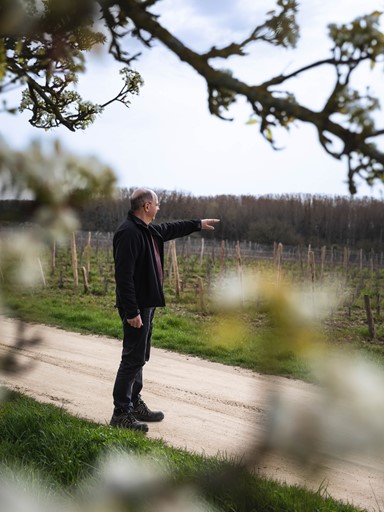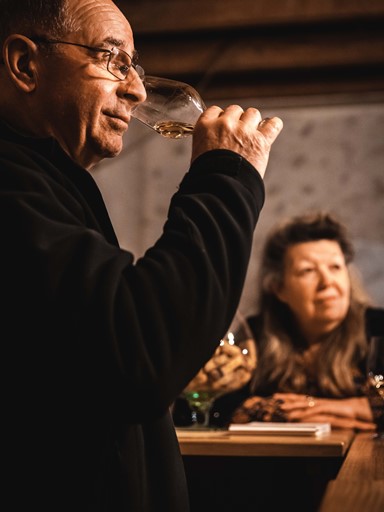
Domaine de Veilloux
France, Loire
The Story
Domaine de Veilloux is a small estate near Cheverny, a quiet part of the Eastern Touraine in the Loire Valley. The estate has been family-owned since the French Revolution, and six generations of the Quenioux family have worked the land. Almost 30 years ago, Michel Quenioux and his wife Sylviane took the reins, and have transformed the estate into an archetype for organic and biodynamic farming in the region. Michel, a firm believer in the health and environmental benefits of clean agriculture, implemented these practices from the start and has spent more than two decades as a spokesman for organic winemaking and the Cheverny region.
The domaine now includes 25 hectares of vines that thrive on the healthy soils and biodiversity he has meticulously restored. Michel uses zero chemical herbicides or pesticides, relying instead on herbal infusions and biodynamic preparations to control weeds and manage disease. A large pond near the domaine brings and array of insects and animals to the vineyards. During our recent visit we saw plenty of spiders and a small hare amongst the vines, and several deer roaming near the forest.
Domaine de Veilloux produces three whites – Sauvignon Blanc, Menu Pineau (Orbois) and Romorantin - three reds – Pinot Noir, Gamay, Cabernet Franc and Côt - and two sparkling wines – a Crémant from Chardonnay and Orbois, and a 100% Orbois pét nat.
Almost all of the wines are blends, and hands-off winemaking ensures the integrity of each variety. He uses a gravity fed system when he can, fermentation is by indigenous yeasts and use of sulphur dioxide is limited. Ageing periods are usually long, resulting in layered, complex wines with the freshness typical of the Cheverny appellation.
Click here to read more about Domaine de Veilloux's use of Romorantin.
View Wines"We try to work as much as possible only with living things. Everything we do, everything we make is thanks to nature. So we must stay as much as possible in the purity of nature.”
The People
Michel & Sylviane
When Michel Quenioux took over the domaine from his parents, his first task was to convert the farm to organic viticulture, which was controversial at the time.
He made the decision to switch to organic for the quality of wine first, then for health concerns. Many of his fellow winemakers scoffed at the idea of organic wines, insisting they were too fragile or lacked complexity. But by the early 90’s, Michel had already tasted several wines he greatly admired, only to find out later they were organic, and he knew the possibilities were there. He also saw first-hand the effects of chemicals on the soil, and on friends and family who experienced side effects from drinking commercially-made wines. When he saw the results of a chemical analysis of his wines, he was shocked, and would lay awake at night worrying about about the health of the land and the people who drink his wines.
He knew he had to change and do better.
Follow
"I thought, this is not right. We are poisoning ourselves, very slowly. So we stopped everything. And changed everything.”
Teamwork
The domaine obtained organic certification in 1998. Michel also employed a consultant to help with the transition to biodynamics. The domaine is certified by Ecocert, though one only needs to look at his robust wines for confirmation.
Michel speaks like a farmer first. He is intensely focused on the quality of the sun, the grasses and the health of the soil and plans his life according to the seasons and the calendar. He believes that there is only one path to great wine: and it starts and stops with happy soils. He says, “We looked at it and asked how can we do things the most naturally way possible, not being concerned with what was done in the past."
Maintaining a large organic domaine is tough work, and while he does as much as he can himself, he also relies on a loyal staff of five who help in all aspects of the domaine.
The most essential of that team is his wife Sylviane, who manages the administrative and marketing side of the domaine. She also serves as a bit of a watchdog – warning Michel when he has spent too much time working, not enough time sleeping, or takes on too many projects. The two share an obvious passion for their wines and their region and delight in sharing them with others. During our last tasting they both returned to the cellar several times to bring back older vintages they wanted to share.

"I am passionate about wine, but I am first passionate about agriculture."
The Place
Cheverny, Loire, France
The Sologne area of the Loire is a fascinating yet often overlooked part of this vast viticultural region. Once a playground for kings and nobles, it is now a mostly agricultural landscape dotted with magnificent châteaux. About 12 kilometres northeast of the village of Cheverny and its famous castle, is Domaine de Veilloux.
The land was part of Château de Fougères-sur-Bièvre, an estate that dates to the 14th century. After the French Revolution the castle and the land were taken from the nobility, broken up and sold off. Members of the Quenioux family were working there at the time, on plots of mixed crops planted alongside vines. The family was able to purchase the land and it has remained in their hands ever since, passing from generation to generation over the centuries. In 1994 Michel brought together, under his direction, all the plots owned by the family.
Across the 25 hectares, the soils are predominantly clay, but with varying percentages of sand or flint. The soils change quite substantially within very short distances, leading to different grapes being planted next to one another in some plots.
Michel prefers to use clones as little as possible, choosing old massale selections instead. He knows these vines are less productive, but feels the quality and texture of the final wines are better. All of the old vines are hand-harvested, but some of the white grapes are harvested late at night to protect as much of the freshness as possible.
Although white wines from Cheverny tends to focus on Sauvignon Blanc and Chardonnay, Michel gives extra attention to Menu Pineau (Orbois), which gives his wines a distinctive edge. The domaine has 3.5 hectares of Orbois, which Michel claims is largest single planting in the world. This rare grape has less than 180 hectares globally, and most of that in is France. It is used in all of his white cuvées except one (the 100% "Romorantin") and he even makes a pét nat completely from the grape. In the domaine cuvée, where it is just 15% of the blend, it adds an extra textural and flavour element. In "Argilo", it makes up 40% of the final blend and completely transforms the wine. For "Les Veilleurs" the percentage increases even further and the wine is an absolute benchmark for the possibilities of this grape.
He is also passionate about Romorantin, another grape that is historically linked to this area but often misunderstood. He makes a single-varietal Romorantin that is one of the finest examples made of this unique variety. Even his Côt is a rare variant called Le Madeline, with origins in this tiny corner of the Loire. He feels it is his obligation to grow these grapes and make the best examples of their potential in order to ensure their future.
Cheverny wines are mandated to be blends, and all but one of the seven wines Domaine Veilloux produces are blends. Some winemakers vary the percentages per year based on conditions in the vintage, but Michel prefers to keep a similar profile every year, so the makeup remains virtually the same. If conditions vary greatly in a certain vintage and a specific wine would be dramatically different, Michel chooses to not make that cuvée rather than modify the style. If the quality is not there, he will not put his name on it.
His winemaking and ageing cellar is a winding labyrinth filled with a cornucopia of presses, vats, ageing vessels and barrels in all sizes and types. He even has several in-ground fermentation tanks, similar to those used in the Pays Nantais. These resin-lined cement tanks were made in the 70’s, but Michel has completely restored them and considers them extremely practical, as they are naturally cooler and provide more stable temperatures. He sources all his new barrels from a local tonnellerie (barrel-maker) that uses oak from the Loire. There are more than 50 acres of oak forest surrounding the domaine, and Michel likes to think his vines and those trees are united together to make great wines.
We agree wholeheartedly, and are proud to share Michel’s wines and support his continued efforts to shine a spotlight on this often overlooked part of the Loire. Domaine Veilloux wines offer incredible value and his unique blends are a fresh alternative to the expected grapes of the Loire. We advise ordering multiple bottles – these are wines that tend to be enjoyed quickly and leave the drinker wanting more.
Location“These old grapes are the patrimoine francais. We must protect and preserve them”
Images by Matt Hickman
Words by Allison Burton-Parker

















